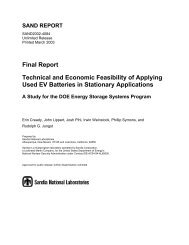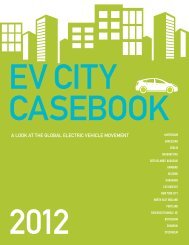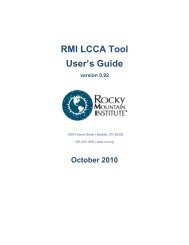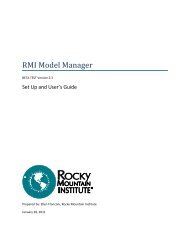Fleet Electrification Roadmap
Fleet Electrification Roadmap
Fleet Electrification Roadmap
- No tags were found...
You also want an ePaper? Increase the reach of your titles
YUMPU automatically turns print PDFs into web optimized ePapers that Google loves.
30 primer: electrification of the transportation sectorspecial sectionspecial sectionfleet electrification roadmap 31FIGURE P13Oil Demand, ChinaThe Case for <strong>Electrification</strong>10 Million Barrels per Day8642019911992Sources: DOE, EIA199319941995production within the world’s most developed nations—the 30 members of the Organization for EconomicCooperation and Development (OECD)—peaked in1997 and has markedly declined each year since 2002. 49Outside the OECD, the picture is no more encouraging.More than 90 percent of global oil supplies are owned bystate-run national oil companies (NOCs). 50 While a handfulof NOCs operate like private firms at the technologicalfrontier of the industry, the majority function essentiallyas a branch of their respective central governments,depositing oil revenues in the treasury, from which theyare often diverted to other programs instead of beingreinvested in new energy projects. 51Meanwhile, the fraction of global oil reserves thatis accessible to international oil companies (IOCs) isgrowing increasingly complex and costly to produce. 52In addition to the typical costs for pipelines, tankers, andrefineries, IOCs must now invest significant additionalcapital per barrel of oil produced for specialized drillingequipment, oversized offshore platforms, and advancedupgrading facilities. As a result, the cost of production forincremental non-OPEC oil reserves has increased rapidlyin recent years. Currently, the break-even price forCanadian oil sands is estimated at between $50 and $80per barrel. 53 For projects in the Gulf of Mexico, marginal49 BP plc, Statistical Review of World Energy 2009, at 8.50 IEA, WEO 2008, Table 14.1.51 Valerie Marcel, "States of Play," Foreign Policy (Sept/Oct 2009).52 IEA, WEO 2008, at 343-53 (2008); Bernstein Research, “GlobalIntegrated Oils: Breaking Down the Cost Curves of the Majors, andDeveloping a Global Cost Curve for 2008,” at 14 - 34 (Feb. 2, 2009).53 Bloomberg Business Week, “Production Costs Climb for Canadian OilSands, Companies Say,” June 2, 2010.19961997199819992000200120022003200420052006200720082009costs are estimated to be $60 per barrel. 54 Promisingbasins off the coast of Brazil, the West Coast of Africa, andthe Former Soviet Union are equally complex and costly.With these factors in mind, a strong case can be made thathigh oil prices are here to stay.In fact, oil prices and supply-demand dynamics thathave occurred in the global oil market throughout 2010have served to reinforce this case. With global oil demandstill recovering from the shock of the financial crisis,notional OPEC spare capacity is currently 5.1 million barrelsper day, a level last witnessed throughout 2001 and2002, when oil prices averaged $20 to $30 per barrel. 55Current commercial inventories are also at generouslevels. U.S. commercial crude oil stocks were 358 millionbarrels as of late September 2010, more than 15 percentabove recent averages for September. 56 Gasoline and dieselstocks are similarly bloated, and the story is roughlythe same throughout the world. The world is awash inoil and global demand is only now returning to pre-crisislevels. And yet, crude oil prices have averaged more than$75 per barrel throughout 2010, a level that would haveseemed exorbitant as recently as 2003.54 DOE, EIA, “Performance Profiles of Major Energy Producers 2008,” at24 (December 2009).55 DOE, EIA, Short Term Energy Outlook, Custom Table Builder, availableonline at http://www.eia.doe.gov/emeu/steo/pub/cf_query/index.cfm,last accessed October 29, 2010.56 DOE, EIA, Weekly Petroleum Status Report (October 6), availableat http://www.eia.gov/pub/oil_gas/petroleum/data_publications/weekly_petroleum_status_report/historical/2010/2010_10_06/wpsr_2010_10_06.html, last accessed October 29, 2010.20102011<strong>Electrification</strong> of transportation remains the most promisingnear-term opportunity for fundamentally reducing U.S.dependence on petroleum. Traditional gasoline electrichybrid electric vehicles (HEVs) offering gasoline efficiencyimprovements of 25 to 50 percent—or more— for amidsize car have been available for a decade and the technologyis generally mature. 57 More recently, there havebeen significant advancements in the technology neededto produce vehicles that can charge onboard batterieswith electricity from the grid, offering a fundamentalbreak from petroleum consumption in transportation.Though important challenges remain, the globalautomotive industry has invested heavily in a numberof grid-powered vehicle platforms that allow for variousranges of autonomous driving powered solely by electricity.In general, grid-enabled vehicles can be either pureelectric vehicles (EVs) or plug-in hybrid electric vehicles(PHEVs). Both EVs and PHEVs store energy from the gridin on-board batteries. Energy from the battery powers a57 The Honda Insight was introduced in the U.S. in 1999 followed by theToyota Prius in 2000. Fuel efficiency improvement figures can varywidely based on the method of comparison. According to DOE’s 2010Fuel Economy Guide (http://www.fueleconomy.gov/feg/FEG2010.pdf ), a Ford Fusion FWD Ice vehicle rates at 22/31 mpg city/hwy. TheFusion Hybrid FWD rates at 41/36. Using a weighted harmonic mean,the efficiency improvement in combined mpg would be 49 percent. Incomparison, the Toyota Prius rates at 51/48 mpg.FIGURE P14<strong>Electrification</strong> Architecture48% Coal22% Natural Gas20% Nuclear9% RenewablesElectric Gridhighly-efficient electric motor that propels the vehicle.EVs substitute an electric drivetrain for all conventionaldrivetrain components. PHEVs retain the use of a downsizedinternal combustion engine that supplements batterypower.To be sure, continued improvements in the internalcombustion engine—along with the targeted uptake ofother alternative fuel vehicletechnologies — can andshould play a role in effortsto improve U.S. energy security.However, grid-enabledvehicles offer an entirelynew prospect: a transportationsystem delinked fromoil. Convergence betweenthe power and transportsectors could fundamentallyalter the U.S. energysecurity equation. Vehiclespowered by electricity fromthe grid consume no petroleum while they are operatingon energy discharged from the battery. The benefits ofsuch a propulsion system are enhanced by key featuresof the electric power sector as well as the vehicle technologyitself.ResidentialHome<strong>Electrification</strong> oftransportation remainsthe most promisingnear-term opportunityfor fundamentallyreducing America'sdependence on oil.·············· Power Generation ······················· Transmission & Distribution ···························· Vehicle Charging ······················Workplace30 MI90% of U.S. vehicle tripsare less than 30 miles.RetailLocations
















